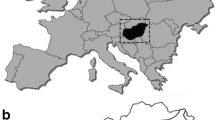Summary
The question discussed in this study is how to calculate linear trends in data that are not distributed evenly in time. This is examined with time series of ten climate elements at a single station, stratified according to a classification based on daily circulation patterns. Trends are calculated in three different ways: (i) from seasonal means, which is a common approach, (ii) from means of individual events, the event being defined as a sequence of days classified as one particular type, preceded and succeeded by another type, and (iii) from individual daily values. The most common method of estimating trend significance, i.e. the t-test of the Pearson correlation coefficient, has been shown to be applicable to seasonal and event-mean trends for all variables. For daily trends, the Monte Carlo test should be used instead. The daily, event-mean and seasonal trends differ from each other considerably for many combinations of climate variable and circulation type. The reason for this difference is identified.
Similar content being viewed by others
Author information
Authors and Affiliations
Additional information
Received December 3, 1998 Revised June 21, 1999
Rights and permissions
About this article
Cite this article
Huth, R. Testing for Trends in Data Unevenly Distributed in Time. Theor Appl Climatol 64, 151–162 (1999). https://doi.org/10.1007/s007040050119
Issue Date:
DOI: https://doi.org/10.1007/s007040050119




